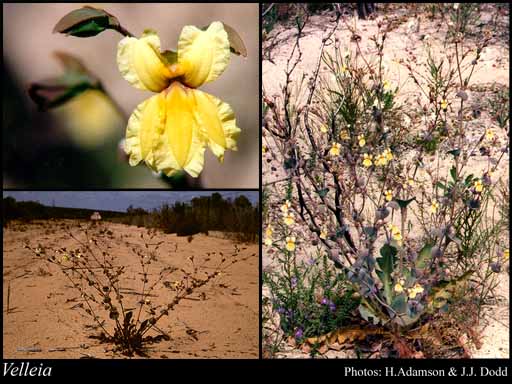This name is not current. Find out more information on related names.
- Reference
- Trans.Linn.Soc.London,Bot. 4:217 (1798)
- Name Status
- Not Current







Scientific Description
Common name. Velleias. Family Goodeniaceae.
Habit and leaf form. Herbs. Annual, or perennial. Leaves basal, or cauline. Plants with a basal concentration of leaves, or with neither basal nor terminal concentrations of leaves. Stem internodes solid (ass.). Mesophytic, or xerophytic. Leaves alternate, or opposite to whorled; spiral; petiolate; non-sheathing; simple; epulvinate. Leaf blades dissected, or entire; flat; ovate, or obovate, or oblong, or elliptic; when dissected, pinnatifid, or runcinate; pinnately veined; cross-venulate. Leaves without stipules. Leaf blade margins entire, or serrate, or dentate. Leaves without a persistent basal meristem. Leaf anatomy. Hairs present (axillary hairs conspicuous), or absent; complex hairs present, or absent. Extra-floral nectaries absent (ass.). Stem anatomy. Secondary thickening absent, or developing from a conventional cambial ring.
Reproductive type, pollination. Fertile flowers hermaphrodite. Unisexual flowers absent. Plants hermaphrodite. Entomophilous. Pollination mechanism conspicuously specialized (involving a stylar modification for pollen presentation).
Inflorescence and flower features. Flowers solitary, or aggregated in ‘inflorescences’; in cymes (in dichasia). The terminal inflorescence unit cymose. Inflorescences scapiflorous; axillary; scapes erect to prostrate, cymes dichotomous. Flowers pedicellate (not articulate); bracteate (opposite, free or connate); bracteolate (opposite, usually large and leaf-like, broadly ovate to semicircular, connate at least on one side); small to medium-sized; very irregular. The floral asymmetry involving the perianth and involving the androecium. Flowers 5 merous; cyclic; tetracyclic. Free hypanthium absent. Hypogynous disk present, or absent. Perianth with distinct calyx and corolla; (8–)10; 2 -whorled; isomerous, or anisomerous. Calyx present; (3–)5; 1 -whorled; polysepalous, or gamosepalous; campanulate, or tubular. Corolla present; 5; 1 -whorled; appendiculate (the upper lobes auriculate); gamopetalous; lobed. Corolla tube adaxially deeply split. Corolla lobes valvate; bilabiate; white (rarely), or yellow (usually), or orange (usually), or pink (or mauve); spurred (obscurely), or not spurred. Androecial members definite in number. Androecium 5. Androecial members free of the perianth, or adnate; all equal (ass.); free of one another; 1 -whorled. Androecium exclusively of fertile stamens. Stamens 5; all more or less similar in shape (ass.); isomerous with the perianth; oppositisepalous (at the base of the corolla); all alternating with the corolla members. Anthers separate from one another; basifixed; dehiscing via longitudinal slits; introrse; tetrasporangiate. Pollen shed in aggregates, or shed as single grains. Gynoecium 2 carpelled. The pistil 1–2 celled. Gynoecium syncarpous; synstylovarious to eu-syncarpous; superior (or apparently so). Ovary plurilocular; 2 locular (incompletely); sessile (ass.). Gynoecium stylate. Styles 1; bearing an ‘indusium’ beneath the stigma. Indusium cupular. Styles apical. Stigmas 1; 2 - lobed. Placentation axile. Ovules 4–20 per locule; ascending; non-arillate; anatropous.
Fruit and seed features. Fruit non-fleshy; dehiscent; a capsule. Capsules valvular. Fruit 2 celled (or 4); usually more than 2 per locule. Seeds copiously endospermic. Endosperm oily. Seeds compressed; winged, or wingless. Cotyledons 2. Embryo straight.
Special features. The upper lip of the corolla incorporating 2 members, the lower 3; (posterior, adaxial) lip of the corolla bilobed. Lower (abaxial) lip of the corolla 3 lobed.
Etymology. After Thomas Velley (1748–1806), English botanist, specialist on seaweed and other marine plants.
Taxonomic Literature
- Wheeler, Judy; Marchant, Neville; Lewington, Margaret; Graham, Lorraine 2002. Flora of the south west, Bunbury, Augusta, Denmark. Volume 2, dicotyledons. Australian Biological Resources Study.. Canberra..
- Australian Biological Resources Study 1992. Flora of Australia. Volume 35, Brunoniaceae, Goodeniaceae. Australian Govt. Pub. Service.. Canberra..
- Wheeler, J. R.; Rye, B. L.; Koch, B. L.; Wilson, A. J. G.; Western Australian Herbarium 1992. Flora of the Kimberley region. Western Australian Herbarium.. Como, W.A..